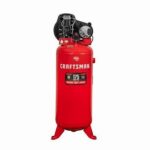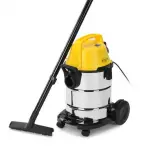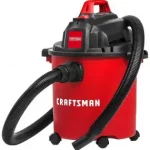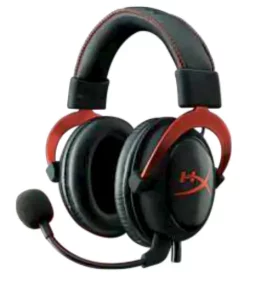

![]() IF YOU HAVE ANY QUESTIONS OR COMMENTS, CONTACT US.
IF YOU HAVE ANY QUESTIONS OR COMMENTS, CONTACT US.
1-888-331-4569
Copyright ID 21118. Sri!Los & Stratton Corporation
Milwaukee, WI, USA. All rights rese!Ved. ReseiVOdos rodos los deredlos.
CRAFTSMAN’ is o registered trademark of old Slllnley Block & Decker, Inc, used under license.
CRAFTSMAN’ es Uno morocco registred de Slllnley Block & Decker. Inc, uso obojo liceocio.
Monuol No. B003ons Revision A
Operator Safety
Equipment Description
![]() Read this manual carefully and become familiar with your V pressure washer. Know its applications, its limitations, and any hazards involved.
Read this manual carefully and become familiar with your V pressure washer. Know its applications, its limitations, and any hazards involved.
This pressure washer operates at a maximum of 3,200 PS I (221 BAR) at a flow rate of up to 2.4 gallons (9.0 I) per minute. This high-quality residential system features 10″ (25.4 em) wheels, axial cam pump with stainless steel pistons, automatic cool-down system, detergent tank, nozzle extension with quick connect fitting, a variety of quick-connect spray tips, heavy-duty 30 ft. (9.1 m) hose, and more.
Every effort has been made to ensure that information in this manual is accurate and current. However, we reserve the right to change, alter, or otherwise improve the product
and this document at any time without prior notice.
The Emission Control System for this pressure washer is warranted for standards set by the Environmental Protection Agency and the California Air Resources Board.
Important Safety Information
Safety Symbols and Meanings
![]()
![]() The safety alert symbol indicates a potential personal injury hazard. A signal word (DANGER, WARNING, or CAUTION) is used with the alert symbol to designate a degree or level of hazard seriousness. A safety symbol may be used to represent the type of hazard. The signal word NOTICE indicates information considered important, but
The safety alert symbol indicates a potential personal injury hazard. A signal word (DANGER, WARNING, or CAUTION) is used with the alert symbol to designate a degree or level of hazard seriousness. A safety symbol may be used to represent the type of hazard. The signal word NOTICE indicates information considered important, but
not hazard-related.
![]() DANGER indicates a hazard that, if not avoided, will result In death or serious injury.
DANGER indicates a hazard that, if not avoided, will result In death or serious injury.
![]() WARNING indicates a hazard that, if not avoided, could result in death or serious injury.
WARNING indicates a hazard that, if not avoided, could result in death or serious injury.
![]() CAUTION Indicates a hazard that, if not avoided, could result in minor or moderate injury.
CAUTION Indicates a hazard that, if not avoided, could result in minor or moderate injury.
NOTICE indicates informatiOn considered important, but not hazard-related.
![]() WARNING POISONOUS GAS HAZARD. Engine
WARNING POISONOUS GAS HAZARD. Engine
![]()
exhaust contains carbon monoxide, a poisonous gas that could kill you in minutes. You
CANNOT smell it, see it, or taste it. Even if you do not smell exhaust fumes, you could still be exposed to carbon monoxide gas. Some chemicals or detergents could be harmful if inhaled or ingested, resulting in death, serious injury, nausea, fainting, or poisoning.
- Operate this product ONLY outside far away from windows, doors, and vents to reduce the risk of carbon monoxide gas accumulating and potentially being drawn towards occupied spaces.
- Install battery-operated carbon monoxide alarms or plug-in carbon monoxide alarms with battery back-up according to the manufacturer’s instructions. Smoke alarms cannot detect carbon monoxide gas.
- Do NOT run this product inside homes, garages, basements, crawlspaces, sheds, or other partially-enclosed spaces even if using fans or opening doors and windows for ventilation. Carbon monoxide can quickly build up in these spaces and can linger for hours, even after this product has shut off.
- ALWAYS place this product downwind and point the engine exhaust away from occupied spaces. If you start to feel sick, dizzy, or weak while using this product, get to fresh air RIGHT AWAY. See a doctor. You may have carbon monoxide poisoning.
- Use a respirator Ol mask whenever there is a chance that vapors may be inhaled when using chemicals.
- Read all instructions with a mask so you are certain the mask will provide the necessary protection against inhaling harmful vapors when using chemicals.
![]() WARNING This product can expose you to chemicals including gasoline engine exhaust, which is known to the State of California to cause cancer, and carbon monoxide, which is known to the State of California to cause birth defects or other reproductive harm. For more inform at ion go to www.P65Warnings.ca.gov.
WARNING This product can expose you to chemicals including gasoline engine exhaust, which is known to the State of California to cause cancer, and carbon monoxide, which is known to the State of California to cause birth defects or other reproductive harm. For more inform at ion go to www.P65Warnings.ca.gov.
![]() WARNING This product contains lead and lead compounds, known to the state of California to cause birth defects or other reproductive harm. Wash your hands after handling this product. Cancer and Reproductive Harm- www.P65Warnings.ca.gov
WARNING This product contains lead and lead compounds, known to the state of California to cause birth defects or other reproductive harm. Wash your hands after handling this product. Cancer and Reproductive Harm- www.P65Warnings.ca.gov
![]() WARNING Exhaust heat/gases could ignite combustibles, structures or damage the fuel tank causing a fire, resulting in death or serious injury.
WARNING Exhaust heat/gases could ignite combustibles, structures or damage the fuel tank causing a fire, resulting in death or serious injury.
![]() Contact with the muffler area could cause burns resulting in serious injury.
Contact with the muffler area could cause burns resulting in serious injury.
- DO NOT touch hot parts and AVOID hot exhaust gases.
- Allow equipment to cool before touching.
- Keep at least 5 ft. (1.5 m) of clearance on all sides of the pressure washer including overhead.
- It is a violation of the California Public Resource Code, Section to use or operate the engine on any forest-covered, brush-covered, or grass-covered land unless the exhaust system is equipped with a spark arrester, as defined in Section 4442, maintained in effective working order. Other states or federal jurisdictions may have similar laws. Contact the original equipment manufacturer, retailer, or dealer to obtain a Spark °Hester designed for the exhaust system installed on this engine.
- Replacement parts must be the same and installed in the same position as the original parts.
![]() WARNING Risk of electrocution.
WARNING Risk of electrocution.
![]() Contact with a power source could cause electric shock or burn to result in death or serious injury.
Contact with a power source could cause electric shock or burn to result in death or serious injury.
- NEVER spray near the power source.
![]() WARNING Use of a pressure washer could create puddles
WARNING Use of a pressure washer could create puddles
![]() and slippery surfaces causing you to fall – resulting in death or serious injury.
and slippery surfaces causing you to fall – resulting in death or serious injury.
Kickback from a spray gun could cause you to fall resulting in death or serious injury.
- Operate pressure washer from a stable surface.
- The cleaning area should have adequate slopes and drainage to reduce the possibility of a fall due to slippery surfaces.
- Be extremely careful if you must use the pressure washer from a ladder, scaffolding, or any other similar location.
- Firmly grasp the spray gun with both hands when using high-pressure spray to avoid injury when the spray gun kicks back.
![]() WARNING Chemical Burn Hazard.
WARNING Chemical Burn Hazard.
![]() Chemicals could cause burns resulting in death- or serious injury.
Chemicals could cause burns resulting in death- or serious injury.
- DO NOT use caustic liquid with a pressure washer.
- Use ONLY pressure washer-safe detergents/soaps. Follow all manufacturer’s instructions.
![]() WARNING Fuel and its vapors are extremely
WARNING Fuel and its vapors are extremely
![]() flammable and explosive which could-cause burns, fire or_explosion resulting in 10 death or serious InJ Ury.
flammable and explosive which could-cause burns, fire or_explosion resulting in 10 death or serious InJ Ury.
WHEN ADDING DR DRAINING FUEL
- Turn pressure washer engine OFF and let It cool at the feast 2 minutes before removing the fuel cap. Loosen cap slowly to relieve pressure in the tank.
- Foil or drain fuel tank outdoors.
- DO NOT overfill the tank. Allow space for fuel expansion.
- If fuel spills, wait until it evaporates before starting the engine.
- Keep fuel away from sparks, open flames, pilot lights, heat, and other ignition sources.
- Check fuel lines, tank, cap, and fillings frequently for cracks or leaks. Replace if necessary.
- DO NOT light a cigarette or smoke.
WHEN STARTING EQUIPMENT
- Ensure spark plug, muffler, fuel cap, and air cleaner are in place.
- DO NOT crank engine with spark plug removed.
WHEN OPERATING EQUIPMENT
- DO NOT operate this product inside any building, carport, porch, mobile equipment, marine applications, or enclosure.
- DO NOT tip engine or equipment at an angle that causes fuel to spill.
- DO NOT spray flammable liquids.
WHEN TRANSPORTING, MOVING, OR REPAIRING EQUIPMENT
- Transport/move/repair with fuel tank EMPTY or with fuel shutoff valve OFF (0).
- DO NOT tip engine or equipment at an angle which causes fuel to spill.
- Disconnect spark plug wire.
WHEN STORING FUEL OR EQUIPMENT IN THE FUEL TANK
- Store away from furnaces, stoves, water heaters, clothes dryers, or other appliances that have a pilot light or other ignition source because they could ignite fuel vapors.
![]() WARNING Starter cord kickback (rapid retraction)
WARNING Starter cord kickback (rapid retraction)
![]() will pull hand and arm toward engine faster than you can let go which could cause broken bones, fractures, bruises, or sprains resulting in serious injury.
will pull hand and arm toward engine faster than you can let go which could cause broken bones, fractures, bruises, or sprains resulting in serious injury.
- NEVER pull starter cord without first relieving spray gun
pressure. - When starting the engine, pull the cord slowly until resistance is felt and then pull rapidly to avoid kickback.
- After each starting attempt, where the engine fails to run, always point the spray gun in a safe direction, press the red button, and squeeze the spray gun trigger to release high pressure.
- Firmly grasp the spray gun with both hands when using high-pressure spray to avoid injury when the spray gun kicks back.
![]() WARNING The high-pressure stream of water that
WARNING The high-pressure stream of water that
![]() this equipment produces could cut through the skin and its underlying tissues, resulting in serious injury and possible amputation. Spray gun traps high water pressure, even when the engine is stopped and water is disconnected, which could result in serious injury.
this equipment produces could cut through the skin and its underlying tissues, resulting in serious injury and possible amputation. Spray gun traps high water pressure, even when the engine is stopped and water is disconnected, which could result in serious injury.
- If cut by fluid, call the physician immediately. DO NOT treat it as a simple cut.
- DO NOT allow CHILDREN to operate pressure washers.
- NEVER repair high-pressure hose. Replace it.
- NEVER repair leaking connections with a sealant of any kind. Replace o-ring or seal.
- NEVER connect a high-pressure hose to nozzle extension.
- Keep a high-pressure hose connected to the pump and spray gun while the system is pressurized.
- ALWAYS point the spray gun in a safe direction, press the red button and squeeze the spray gun trigger to release high pressure, every time you stop the engine.
- NEVER aim to spray guns at people, animals, or plants.
- DO NOT secure the spray gun in an open position.
- DO NOT leave spray gun unattended while the machine is
- NEVER use a spray gun that does not have a trigger lock or trigger guard in place and in working order.
- Always be certain spray gun, nozzles, and accessories are correctly attached.
![]() WARNING Unintentional sparking could cause fire or
WARNING Unintentional sparking could cause fire or
![]() electric shock resulting in death or ~ serious InJury.
electric shock resulting in death or ~ serious InJury.
WHEN ADJUSTING DR MAKING REPAIRS TO YOUR PRESSURE WASHER
- Disconnect the spark plug wire from the spark plug and place the wire where it cannot contact the spark plug.
WHEN TESTING FOR ENGINE SPARK
- Use approved spark plug tester.
- DO NOT check for spark with spark plug removed.
![]() WARNING Starter and other rotating parts could
WARNING Starter and other rotating parts could
![]() entangle hands, hair, clothing, or accessories ~ resulting in serious injury.
entangle hands, hair, clothing, or accessories ~ resulting in serious injury.
- NEVER operate pressure washer without protective housing or covers.
- DO NOT wear loose clothing, jewelry, or anything that could be caught in the starter or other rotating parts.
- Tie up long hair and remove jewelry.
![]() WARNING Risk of the eye or bodily injury,
WARNING Risk of the eye or bodily injury,![]() Spray could splashback or propel ~ objects resulting In serious injury.
Spray could splashback or propel ~ objects resulting In serious injury.
- Always wear Indirect vented (chemical splash) safety goggles marked to comply with ANSI Z87 .1 when using or in the vicinity of this equipment
- NEVER substitute safety glasses or dry<ondition goggles for Indirectly vented safety goggles.
- Always wear protective clothing such as a long-sleeved shirt, long pants, and close-toed shoes.
- NEVER operate pressure washer when barefoot or wearing sandals or shorts.
![]() CAUTION Excessively high operating speeds could result in minor injury.
CAUTION Excessively high operating speeds could result in minor injury.
Excessively low speeds impose a heavy load.
- DO NOT tamper with governor spring, links, or other parts to increase engine speed. Pressure washer supplies correct pressure and flow when running at governed speed
- DO NOT modify the pressure washer in any way.
NOTICE High-pressure spray could damage fragile items including glass.
- DO NOT point the spray gun at the glass when using a red (0′) spray tip.
- NEVER aim spray gun at plants.
NOTICE Improper treatment of pressure washer could
damage it and shorten its life.
- If you have questions about intended use, ask the dealer or contact the qualified service center.
- NEVER operate units with broken or missing parts, or without protective housing or covers.
- DO NOT bypass any safety device on this machine.
- DO NOT tamper with governed speed.
- DO NOT operate pressure washer above rated pressure.
- DO NOT modify the pressure washer in any way.
- Before starting the pressure washer in cold weather, check all parts of the equipment to be sure ice has riot formed there.
- NEVER move the machine by pulling on hoses. Use the handle provided on the unit.
- This equipment is designed to be used with Briggs & Stratton authorized parts ONLY. If equipment is used with parts that DO NOT comply with minimum specifications, the user assumes all risks and liabilities.
Assembly
Assembly
![]() Read the entire operator’s manual before you attempt to
Read the entire operator’s manual before you attempt to
assemble or operate your new pressure washer.
Your pressure washer requires some assembly and is ready for use after it has been properly serviced with the recommended oil and fuel. If you have problems with the assembly l y of your pressure washer, please call the pressure washer helpline at (888) 331·4569. If calling for assistance, please have the model, revision, and serial number from the identification label available.
Unpack Pressure Washer
- Remove the parts bag, accessories, and inserts included with a pressure washer.
- Open the carton completely by cutting each corner from top to bottom.
- Ensure you have all included items prior to assembly.
Items in the carton include:
- Main Unit
- Handle
- High-Pressure Hose
- Spray Gun
- Nozzle Extension with Quick Connect Fitting
- Plastic Accessory Tray
- Hose Hook Wireform
- Oil Pouch 1/4°C
- Parts Bag (which includes the following):
- Operator’s Manual
- Bag of 4 Multi-Colored Quick Connect Spray Tips
- Rubber Strap
- Hardware Kit (which includes):
- Carriage Bolts (2)
- Plastic Knobs (2)
- Tree Clips (4)
- Rope Guide
- Plastic Knob
Attach Handle and Accessory Tray
- Place handle (A) onto handle supports connected to the main unit. Make sure holes in the handle align with holes on handle supports.
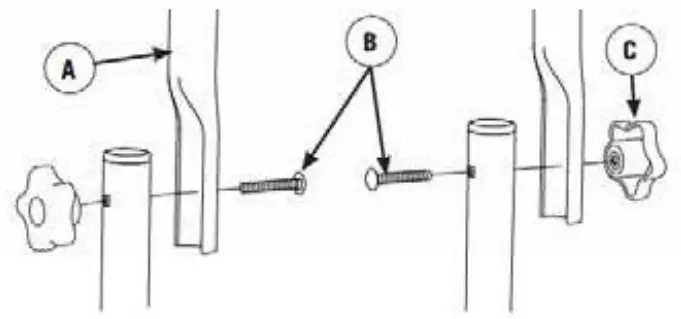
- Insert carriage bolts (B) through holes from inside of the unit and attach a plastic knob (C) from outside of the unit. Tighten by hand.
- Place accessory tray (D) over holes (E) on the handle (viewing from the front of the unit). Push tree clips (F) into the holes until they sit flat against the accessory tray.
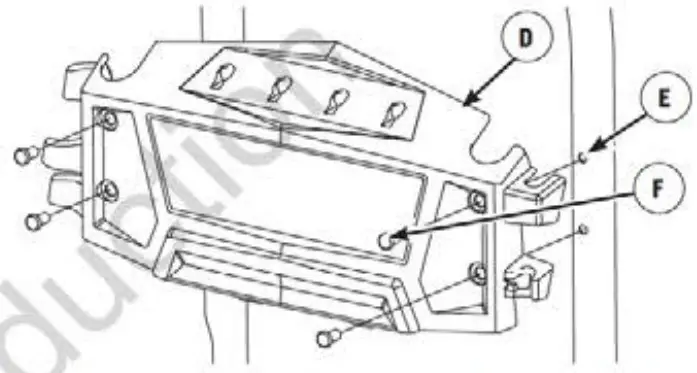
- Attach rope guide (G) through handle with plastic knob (H). Tighten by hand. Route engine recoil rope through the guide
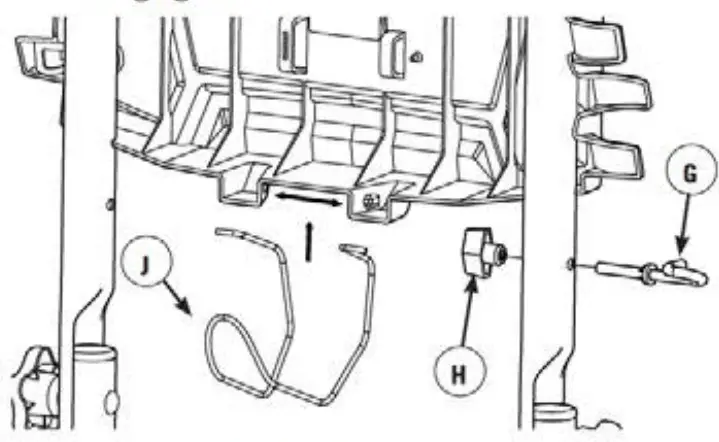
- Squeeze hose hook reform (J) together and insert into grooves at bottom of the accessory tray.
Add Engine Oil and Fuel
- Place pressure washer on a level surface.
- Refer to the engine operator’s manual and follow oil and fuel recommendations and instructions.
NOTICE Any attempt to crank or start the engine before it has been properly filled with the recommended oil will result in equipment failure.
- Reher to engine 111anual for oil and fuel fill intonation.
- Damage to equipment resulting from failure to follow this instruction will void the warranty.
NOTICE Check oil often during engine break-in. Refer to the engine operator’s manual for recommendations.
Lubricate 0-Rings
Lubrication of o-rings is extremely important for installation and operation. The use of a lubricant (petroleum or synthetic grease) during assembly helps seat o-rings properly and provides an improved seal. II also helps protect the O-ring from damage by abrasion, pinching, or cutting and extends the life of the o-ring.
NOTICE ALWAYS apply a small amount of lubricant on o-rings prior to assembling the garden hose to the pump (A), high-pressure hose (B), spray gun (C), and nozzle extension (D).
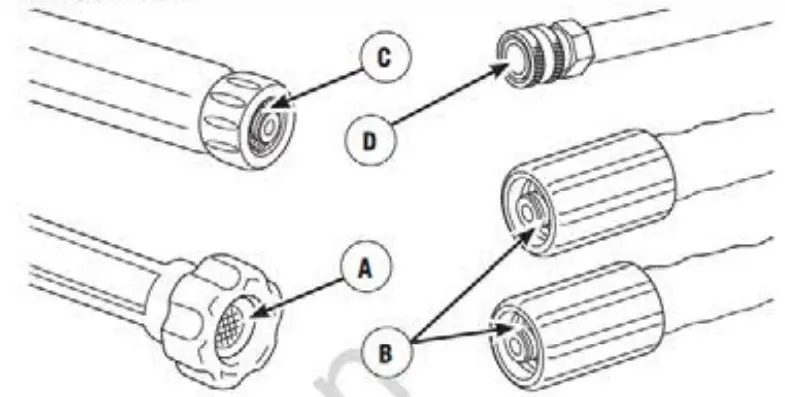
Lubricate all connections shown, following these instructions:
- Inspect and clean connecting surfaces prior to lubrication and assembly.
- Use lubricants sparingly during assembly; a light film is all that is required.
- Use a small brush or cotton swab to apply grease directly to o-rings where they are not accessible (QC fitting, M22 fitting).
Connect Hose and Water Supply to Pump
NOTICE DO NOT run the pump without the water supply connected and turned on,
- Damage to equipment resulting from failure to follow this instruction will void the warranty.
- Uncoil high-pressure hose and attach one end of the hose to the base of the spray gun, Tighten by hand.
 • NEVER connect a high-pressure hose to nozzle extension.
• NEVER connect a high-pressure hose to nozzle extension.
• Keep a high-pressure hose connected to the pump and spray gun while the system is pressurized.
• Always be certain spray gun, nozzles, and accessories are correctly attached. WARNING The high-pressure stream of water that
WARNING The high-pressure stream of water that
 this equipment produces could cut through the skin and its underlying tissues, resulting in serious injury and possible amputation.
this equipment produces could cut through the skin and its underlying tissues, resulting in serious injury and possible amputation. - Attach another end of the high-pressure hose to the high-pressure outlet on the pump. Tighten by hand.
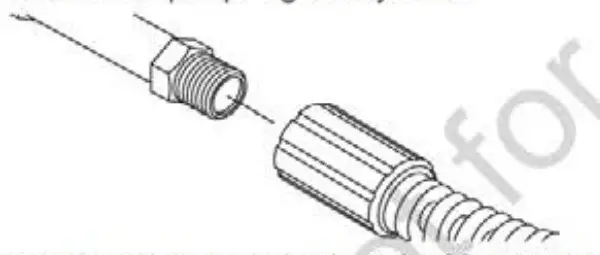
- Run water through your garden hose for 30 seconds to clean out any debris.
NOTICE DO NOT siphon standing water for the water supply. Use ONLY cold water (less than l OO•F (38°C)). - Before connecting the garden hose to the water inlet, inspect the inlet screen (A). Clean screen if it contains debris or has it replaced if damaged. DO NOT run pressure washer if inlet screen is damaged
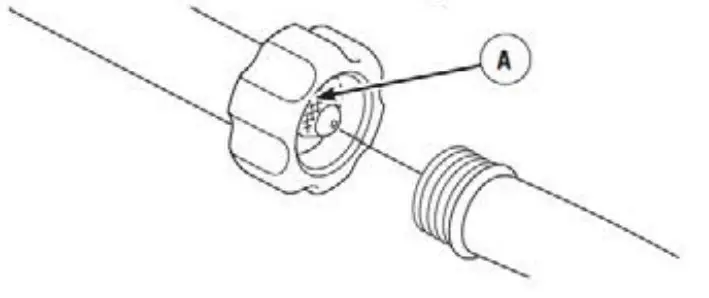 NOTICE Using a One Way Valve (vacuum breaker or check valve) at the pump inlet could cause pump or Inlet connector damage.
NOTICE Using a One Way Valve (vacuum breaker or check valve) at the pump inlet could cause pump or Inlet connector damage.
• There MUST be at least LD II. (3 m) of unrestricted garden hose between the pressure washer inlet and any device, such as a vacuum breaker or check valve.
• Damage to equipment resulting from failure to follow this mslruclion will void the warranty. - Connect the garden hose (not to exceed 50 fl. (15 m) In length) to the water inlet. Tighten by hand.
 WARNING Risk of eye injury.
WARNING Risk of eye injury.
 Spray could splashback or propel objects -resulting in serious injury.
Spray could splashback or propel objects -resulting in serious injury.
• Always wear indirect vented (chemical splash) safety goggles marked to comply with ANSI Z87. I when using or in the vicinity of this equipment.
• NEVER substitute safety glasses or dry-condition goggles for indirectly vented safety goggles.
Turn ON the water, press the red button (B) on the gun, and squeeze the trigger to purge the pump system of air and impurities
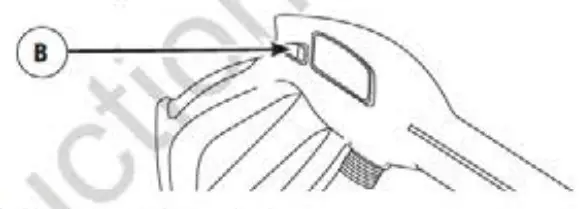
Checklist Before Starting Engine
Review the unit’s assembly to ensure you have performed all of the following.
- Be sure to read Operator Safety and Operation before using a pressure washer.
- Make sure the handle is in place and secure.
- Check that oil has been added to the proper level in the engine crankcase.
- Add proper fuel to the fuel tank.
- Check for properly tightened hose connections.
- Check to make sure there are no kinks, cuts, or damage to the high-pressure hose.
- Provide a proper water supply at an adequate flow.
Features and Controls
![]() Read this Operator’s Manual and safety rules before operating your pressure washer.
Read this Operator’s Manual and safety rules before operating your pressure washer.
Compare the illustrations with your pressure washer, to familiarize yourself with the locations of various controls and adj adjustments. Save this manual for future reference.
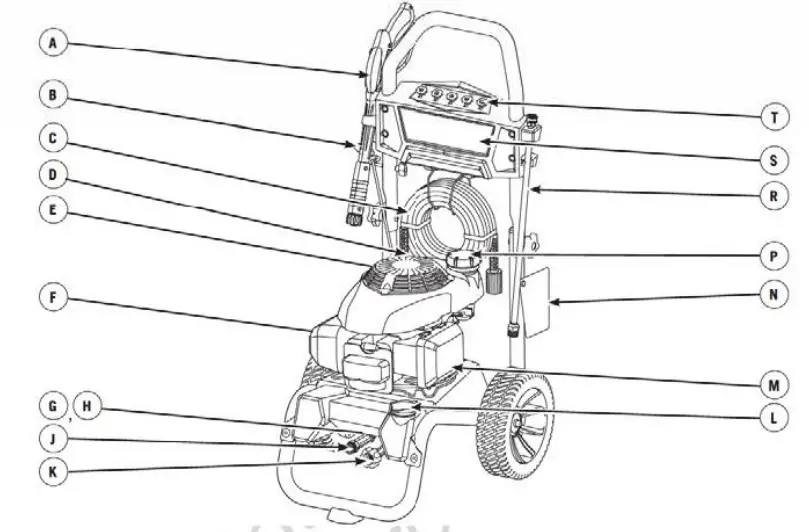
A – Spray Gun — Controls the application of water onto the cleaning surface with a trigger device. Includes trigger lock.
B – Recoil Starter — Used for starting the engine manually.
C – High-Pressure Hose — Connect one end to the water pump and the other end to the spray gun. – Oil FilVDipstick — Check and fill with oil here.
E – Identification Label — Provides model and a serial number of pressure washers. Please have these readily available if calling for assistance.
F – Engine Identification — Provides model, type, and code of the engine. Please have these readily available if calling for assistance.
G – Pump — Develops high pressure.
H – Automatic Cool Down System — Cycles water through the pump when water reaches above 125°F (51°C). Warm water will discharge from the pump onto the ground. This system prevents internal pump damage.
1- High-Pressure Outlet Connection for high pressure
K – Water Inlet Connection for garden hose.
L – Detergent Tank – Use to hold up to one-half gallon (1.9 I) of pressure washer detergent.
M – Air Filter Protects engine by filtering dust and debris out of intake air.
N – Warning/Operating Instructions Tag – Identifies hazards and proper procedure to start/stop pressure washer.
P – Fuel Tank – Fill the tank with regular unleaded fuel. Always leave room for fuel expansion.
R – Nozzle Extension with Quick Connect — Allows you to switch between five different spray tips.
S – Accessory Tray Provides convenient storage for standard and optional accessories, such as brushes, turbo wands, etc.
T – Spray Tips — Jet soap, Jet flush, 0°, 25°, and 40°: for various high-pressure cleaning applications.
Items Not Shown:
Engine Controls See engine manual for details on engine controls.
Operation
Operation
If you have any problems operating your pressure washer, please call the pressure washer helpline ne at (888) 331-4569.
Pressure Washer location
Carbon Monoxide Poisoning
![]() WARNING POISONOUS GAS HAZARD. Engine
WARNING POISONOUS GAS HAZARD. Engine
![]() exhaust contains carbon monoxide, a poisonous gas that could kill you in minutes. You CANNOT smell it, see it, or taste it. Even if you do not smell exhaust fumes, you could still be exposed to carbon monoxide gas.
exhaust contains carbon monoxide, a poisonous gas that could kill you in minutes. You CANNOT smell it, see it, or taste it. Even if you do not smell exhaust fumes, you could still be exposed to carbon monoxide gas.
- Operate this product ONLY outside far away from windows, doors, and vents to reduce the risk of carbon monoxide gas accumulating and potentially being drawn towards occupied spaces.
- Install battery~perated carbon monoxide alarms or plug-in arbon monoxide alarms with battery back-up according to the manufacturer’s instructions. Smoke alarms cannot detect carbon monoxide gas.
- DO NOT run this product inside homes, garages, basements, crawlspaces, sheds, or other partially-enclosed spaces even if using fans or opening doors and windows for ventilation. Carbon monoxide can quickly build up in these spaces and can linger for hours, even after this product has shut off.
- ALWAYS place this product downwind and point the engine exhaust away from occupied spaces. If you start to feel sick, dizzy, or weak while using this product, get to fresh air RIGHT AWAY. See a doctor. You may have carbon monoxide poisoning.
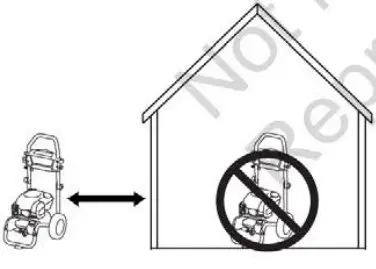
Risk of Fire Clearances
![]() WARNING Exhaust heat/gases could ignite
WARNING Exhaust heat/gases could ignite
 combustibles, structures, or damaged fuel tanks causing a lire, resulting in death or serious injury.
combustibles, structures, or damaged fuel tanks causing a lire, resulting in death or serious injury.
- Keep at least 5 ft. I 1.5 ml clearance on all sides of the pressure washer including overhead.
How to Start Your Pressure Washer
To start your pressure washer for the first time, follow these Instructions step-by-step. This starting information also applies if you have let the pressure washer sit idle for
at least a day.
- Place pressure washer near an outside water source capable of supplying water at a flow rate greater than 3.4 gallons (12.87 I) per minute and no less than 20 PS I (1.3 BAR) at pressure washer end of garden hose. DO NOT siphon supply water.
- Check that high pressure hose is tightly connected to the spray gun and pump. See Assembly section.
- Make sure un it is in a level position .
- Connect a garden hose to water inlet on a pressure washer pump.
NOTICE DO NOT run the pump without the water supply connected and turned on.
• Damage to equipment resulting from failure to follow this instruction will void warranty. - Turn ON water, point the gun in a safe direction, press the red button, and squeeze the trigger to purge the pump system of air and impu rities.
- Attach nozzle extension to spray gun. Tighten by hand.

- Choose the spray tip you want to use, pull back on the collar of the nozzle extension, insert the spray tip and release the collar. Tug on the spray tip to make sure it is securely in place. See How to Use Spray Tips.

NOTICE Before starting the pressure washer, be sure you are wearing safety goggles as described. WARNING Risk of eye injury.
WARNING Risk of eye injury.
 Spray could splashback or propel objects-result ing in serious injury.
Spray could splashback or propel objects-result ing in serious injury.
• Always wear indirect vented (chemical splash) safety goggles marked to comply with ANSI Z87.1 when using or in the vicinity of this equipment.
• NEVER substitute safety glasses or dry-condition goggles for indirectly vented safety goggles. - When starting the engine, position yourself as recommended and start the engine according to instructions given in the engine operator’s manual, Also see the operating instructions tag located on the pressure washer.
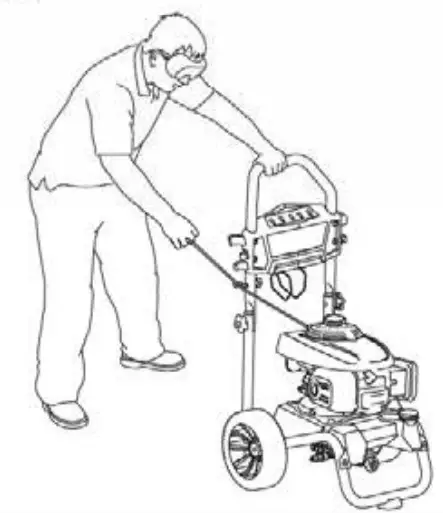
 WARNING Starter cord kickback (rapid retraction)
WARNING Starter cord kickback (rapid retraction)
 will pull hand and arm toward engine faster than you can let go which could cause broken bones, fractures, bruises, or sprains resulting in
will pull hand and arm toward engine faster than you can let go which could cause broken bones, fractures, bruises, or sprains resulting in
serious injury.
• NEVER pull starter cord without first relieving spray gun pressure.
• When starting the engine, pull the cord slowly until resistance is felt and then pull rapidly to avoid kickback.
• After each starting attempt, where the engine fails to run, always point the spray gun in a safe direction, press the red button, and squeeze spray gun trigger to release high pressure.
• Firmly grasp spray gun with both hands when using high-pressure spray to avoid injury when spray gun kicks back. - Return starter grip handles slowly. DO NOT let the rope “snap back” against the starter.
 WARNING The high-pressure stream of water that
WARNING The high-pressure stream of water that
 this equipment produces could cut through the skin and its underlying tissues, resulting in serious injury and possible amputation. Spray gun traps high water pressure, even when the engine is stopped and water is disconnected, which could result in serious injury.
this equipment produces could cut through the skin and its underlying tissues, resulting in serious injury and possible amputation. Spray gun traps high water pressure, even when the engine is stopped and water is disconnected, which could result in serious injury.
• DO NOT allow CHILDREN to operate pressure washers.
• Keep high-pressure hose connected to pump and spray gun while the system is pressurized.
• NEVER aim spray gun at people, animals, or plants.
• DO NOT secure the spray gun in the open position.
• DO NOT leave the spray gun unattended while the machine is running.
• NEVER use a spray gun that does not have a trigger lock or trigger guard in place and in working order.
• Always be certain spray guns, nozzles, and accessories are correctly attached.
![]() WARNING Exhaust heat/gases could ignite
WARNING Exhaust heat/gases could ignite
![]() combustibles, structures or damage the fuel tank causing a fire, resulting in death or serious injury.
combustibles, structures or damage the fuel tank causing a fire, resulting in death or serious injury.
Contact with the muffler area could cause burns resulting in
serious injury.
• DO NOT touch hot parts and AVOID hot eJ<haust gases.
• Allow equipment to cool before touching.
• Keep at least 5 fl. (l.5 m) of clearance on all sides of pressure washer including overhead.
• It is a violation of California Public Resource Code, Section 4442, to use or operate the engine on any forest-covered, brush-Over, or grass-covered land unless the exhaust system is equipped with a spark arrester, as defined in Section 4442, maintained in effective working order. Other states or federal jurisdictions may have similar laws. Contact the original equipment manufacturer, retailer, or dealer to obtain a spark arrester designed for the exhaust system installed on this engine.
• Replacement parts must be the same and installed in the same position as the original parts.
How to Stop Your Pressure Washer
- Release the spray gun trigger and let the engine idle for two minutes.
- Turn the engine off according to instructions given in the engine operator’s manual.
- ALWAYS point the gun in a safe direction and press the red button and squeeze the spray gun trigger to release retained high water pressure.
![]() WARNING The high-pressure stream of water that
WARNING The high-pressure stream of water that
![]() this equipment produces could cut through the skin and its underlying tissues, resulting in serious injury and possible amputation. Spray gun traps high water pressure, even when the engine is stopped and water is disconnected, which could result in serious injury.
this equipment produces could cut through the skin and its underlying tissues, resulting in serious injury and possible amputation. Spray gun traps high water pressure, even when the engine is stopped and water is disconnected, which could result in serious injury.
• Keep high-pressure hose connected to pump and spray gun while the system is pressurized.
• ALWAYS point the spray gun in a safe direction, press the red button, and squeeze the spray gun trigger to release high pressure, every time you stop the engine.
How to Use Accessory Tray
The unit is equipped with an accessory tray with places to store your spray gun, nozzle extension, high-pressure hose, and quick-connect spray tips.
- Place nozzle extension in slots on the left side of accessory tray (viewing from the rear of the unit) and snap-in.
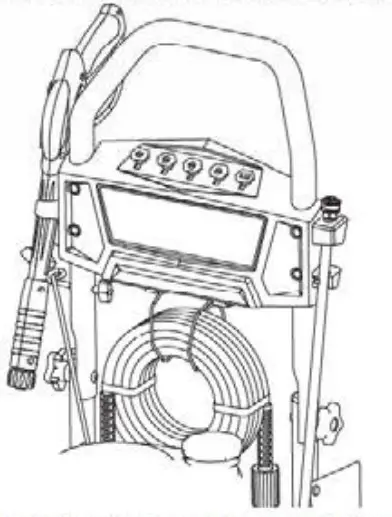
- Place spray gun through grooves on the right side of the accessory tray.
- Insert multi-colored spray tips in holes provided on the front of the accessory tray.
- Wrap a high-pressure hose and hang it on the hook of the accessory tray.
NOTICE There is also a slot for storing a can of Pump Saver on the back. See Pump Saver Storage.
How to Use Spray Tips
The quick-connect on the nozzle extension allows you to switch between five different quick-connect spray tips. Spray tips can be changed while the pressure washer Is running once the spray gun trigger lock is engaged. The spray tips vary the spray pattern as shown.
Follow these instructions to change spray tips:
- Pull back collar on quick-connect and pull current spray tip-off. Store spray tips in holes provided on the accessory tray.
 WARNING The high-pressure stream of water that
WARNING The high-pressure stream of water that
 this equipment produces could cut through the skin and its underlying tissues, resulting in serious injury and possible amputation.
this equipment produces could cut through the skin and its underlying tissues, resulting in serious injury and possible amputation.
• NEVER exchange spray tips without the trigger lock being engaged on the spray gun.
• Do NOT twist spray tips while spraying. - Select desired spray tip:
• For the delicate rinse, for gentle cleaning of cars/ trucks, boats, RV’s, patio furniture, lawn equipment, etc., select white 40° spray tip.
• For general rinsing, ideal for most all-purpose cleaning such as home siding, brick patios, wood decks, driveways and sidewalks, garage floors, etc., select yellow 15° spray tip.
• For maximum rinsing, for stubborn or hard-to-reach surfaces such as second-story surfaces, paint removal, oil stains, rust removal, or other stubborn substances (tar, gum, grease, wax, etc.), select red o° spray tip.
• Select cyan jet flush spray tip for quick high flow clean up and long reach cleaning of the second story siding and windows.
• Select magenta jet soap spray tip for general soap applications or to launch soap to the second-story siding and windows. - Pull back on the collar, insert new spray tip and release collar. Tug on the spray tip to make sure it is securely in place.
Low Pressure
Use to apply detergent
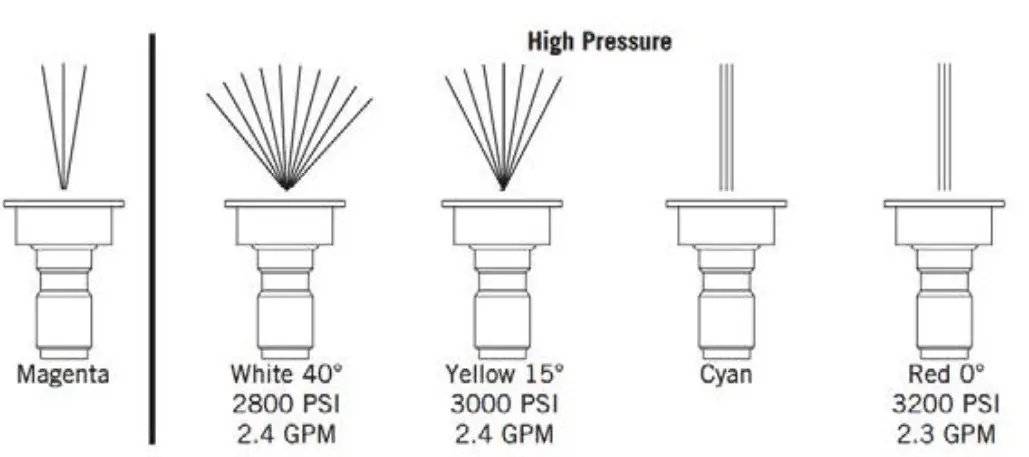
Usage Tips
- For the most effective cleaning, keep the spray tip from 8 to 24 in. away from the cleaning surface.
- If you get the spray tip too close, especially using a high-pressure spray tip, you may damage the surface being cleaned.
- DO NOT get closer than 6 ln. when cleaning tires.
Applying Detergent
![]() WARNING Chemical Burn Hazard.
WARNING Chemical Burn Hazard.
![]() Chemicals could cause burns resulting in death or serious injury.
Chemicals could cause burns resulting in death or serious injury.
- DO NOT use caustic liquid with a pressure washer.
- Use ONLY pressure washer-safe detergents/soaps. Follow all manufacturer’s instructions.
To apply detergent, follow these steps:
- Review use of spray tips.
- Prepare detergent solution as required by the job.
- Pour detergent into cleaning tank.
NOTICE The cleaning tank holds 0.5 gallons (1.9 liters).
- Make sure magenta spray tips are installed.
NOTICE Detergent cannot be applied with high-pressure spray tips (White, Yellow, Cyan, or Red).
- Make sure the garden hose is connected to the water inlet. Check that the high-pressure hose is connected to the spray gun and pump. Turn on the water.
NOTICE You must attach all hoses before you start the engine.
- Starting the engine without all the hoses connected and without the water turned ON could damage the pump.
- Damage to equipment resulting from failure to follow this instruction will void the warranty.
- Start engine following instructions How to Start Your Pressure Washer.
- Apply detergent to a dry surface, starting at a lower portion of the area to be washed and work upward, using long, even, overlapping strokes.
- Allow the detergent to “soak in” for 3-5 minutes before washing and rinsing. Reapply as needed to prevent the surface from drying. DO NOT allow detergent to dry on (prevents streaking).
Pressure Washer Rinsing
For Rinsing:
- Remove magnets detergent spray tip from nozzle
- Select and install desired high-pressure spray tip following instructions Now to Use Spray Tips.
- Keep the spray gun a state distance from the area you plan to spray.
 WARNING Kickback from a spray gun could cause you
WARNING Kickback from a spray gun could cause you to fall resulting in death or serious injury.• Operate pressure washer from a stable surface.
to fall resulting in death or serious injury.• Operate pressure washer from a stable surface.
• Be extremely careful if you must use the pressure washer from a ladder, scaffolding, or any other similar location.
• Firmly grasp spray gun with both hands when using high-pressure spray to avoid injury when spray gun kicks back. - Apply a high-pressure spray to a small area, then check the surface for damage. If no damage is found, it is okay to continue cleaning.
- Start at the top of the area to be rinsed, working down with the same overlapping strokes as you used for washing and applying detergent.
Automatic Cool Down System (Thermal Relief)
If you run the engine on your pressure washer for 3-5 minutes without pressing the trigger on the spray gun, circulating water in the pump can reach temperatures above 1256-155T (51°-68°C). The system engages to cool the pump by discharging the warm water onto the ground.
Maintenance
Maintenance
General Recommendations
Regular maintenance will improve the performance and extend the life of the pressure washer. See any qualified dealer for service.
The pressure washer’s warranty does not cover items that have been subjected to operator abuse or negligence. To receive full value from the warranty, the operator must maintain the pressure washer as instructed in this manual, including proper storage as detailed in Winter Storage and Long Term Storage.
NOTICE Should you have questions about replacing components on your pressure washer, please call (888) 331-4569 for assistance.
Some adjustments will need to be made periodically to properly maintain your pressure washer.
- Some adjustments will need to be made periodically to properly maintain your pressure washer. Check the spray gun and nozzle extension assembly for wear.
- All maintenance in this manual and the engine operator’s manual should be made at least once each season.
- Once a year you should clean or replace the spark plug, clean or replace the air filter. A new spark plug and clean air filter assure proper fuel-air mixture and help your engine run better and last longer. Please refer to your engine operator’s manual (or more details.
Before Each Use
- Check engine oil level.
- Clean debris.
- Check water inlet screen for damage.
- Check the high-pressure hose for leaks.
- Check detergent tube/tank for damage.
- Check spray gun and nozzle extension assembly for leaks.
- Rinse out the garden hose to flush out debris.
Pump Oil
DO NOT attempt any oil maintenance on this pump. The pump is pre-lubricated and sealed from the factory, requiring no additional maintenance for the life of the pump.
Pressure Washer Maintenance
Clean Debris
Daily or before use, clean accumulated debris from a pressure washer. Keep linkage, spring, and controls clean. Keep the area around and behind the muffler free from any combustible debris. Inspect cooling air slots and openings on the pressure washer. These openings must be kept clean and unobstructed.
Pressure washer parts should be kept clean to reduce the risk of overheating and ignition of accumulated debris.
- Use a damp cloth to wipe exterior surfaces clean.
NOTICE Improper treatment of pressure washers could damage it and shorten its life.
- DO NOT insert any objects through cooling slots.
- Use a soft bristle brush to loosen caked-on dirt, oil. etc.
- Use a vacuum cleaner to pick up loose dirt and debris.
Check and Clean Inlet Screen
Examine the screen on the pump’s water inlet. Clean it if the screen is clogged or replace it if the screen is damaged.
Check High-Pressure Hose
The high-pressure hose can develop leaks from wear, kinking, or abuse. Inspect the hose each time before using it. Check for cuts, leaks, abrasions, or bulging of cover, damage, or movement of couplings. If any of these conditions exist, replace the hose immediately.
![]() WARNING The high-pressure stream of water that
WARNING The high-pressure stream of water that
![]() this equipment produces could cut through the skin and its underlying tissues, resulting in serious injury and possible amputat1on.
this equipment produces could cut through the skin and its underlying tissues, resulting in serious injury and possible amputat1on.
- NEVER repair high-pressure hose. Replace it.
- Replacement hose rating MUST equal or exceed the maximum pressure rating of the unit.
Check Detergent Tube/Tank
Examine detergent tank and detergent tube and clean if clogged. The tube should fit tightly on the barbed fitting of the pump and tank. Examine the tube for leaks or tears.
Replace the tank or tube if either is damaged.
Deterrent Siphonine Check Ball
Occasionally check ball in the detergent siphoning system may become stuck from storage, dried soap, or minerals in the water. The check ball can be freed by performing the following:
NOTICE Before performing this procedure, be sure you are wearing safety goggles as described.
![]() WARNING Risk of eye injury.
WARNING Risk of eye injury.
![]() Spray could splash rack or propel objects resulting m serious injury.
Spray could splash rack or propel objects resulting m serious injury.
- Always wear indirect vented (chemical splash) safety goggles marked to comply with ANSI Z87.1 when using or in the vicinity of this equipment.
- NEVER substitute safety glasses or dry-condition goggles for indirectly vented safety goggles.
- Shut OFF the engine and turn off the water supply.
- ALWAYS point the spray gun in a safe direction, press the red button, and squeeze the spray gun trigger to release retained high water pressure.
 WARNING The high-pressure stream of water that
WARNING The high-pressure stream of water that
 this equipment produces could cut through the skin and its underlying tissues, resulting in serious injury and possible amputation. Spray gun traps high water pressure, even when the engine is stopped and water is disconnected, which could result in serious injury.• Keep a high-pressure hose connected to the pump and spray gun while the system is pressurized.
this equipment produces could cut through the skin and its underlying tissues, resulting in serious injury and possible amputation. Spray gun traps high water pressure, even when the engine is stopped and water is disconnected, which could result in serious injury.• Keep a high-pressure hose connected to the pump and spray gun while the system is pressurized.
• ALWAYS point the spray gun in a safe direction, press the red button, and squeeze the spray gun trigger to release high pressure, every time you stop the engine. - Remove Cletergent nose from oreo fitting on the pump.
- Using a firm, blunt object 7/64″ in diameter or smaller, by at least 1″ long, such as an Allen wrench, slowly insert the object into the barbed fitting until you meet resistance. This resistance is the check ball.
- Slowly push down until you feel the ball move slightly, push no more than l/8″. Slight pressure may be required to free the ball.
- Repeat steps 4 and 5 if necessary.
- Reinstall detergent hose onto barb fitting.
- Treat with Pump Saver as described in Protecting the Pump during storage to prevent reoccurrence.
Check Spray Gun
Examine the hose connection to the spray gun and make sure it is secure. Test the trigger by pressing the red button and making sure the trigger “springs back” into place when you release it. You should not be able to press the trigger without pressing the red button. Replace the spray gun immediately if it fails any of these tests.
Spray Tip Maintenance
A pulsing sensation felt while squeezing the spray gun trigger may be caused by excessive pump pressure. The principal cause of excessive pump pressure is a spray t IP clogged or restricted with foreign materials, such as dirt, etc. To correct the problem, immediately clean the spray tip following these instructions:
- Shut OFF the engine and turn off the water supply.
- ALWAYS point the spray gun in a safe direction, press the red button, and squeeze the spray gun trigger to release retained hi11h water pressure.
 WARNING The high-pressure stream of water that
WARNING The high-pressure stream of water that
 this equipment produces could cut through the skin and its underlying tissues, resulting in serious injury and possible amputation. Spray gun traps high water pressure, even when the engine is stopped and water is disconnected, which could result in serious injury.
this equipment produces could cut through the skin and its underlying tissues, resulting in serious injury and possible amputation. Spray gun traps high water pressure, even when the engine is stopped and water is disconnected, which could result in serious injury.
• Keep high-pressure hose connected to pump and spray gun while the system is pressurized.
• ALWAYS point the spray gun in a safe direction, press the red button, and squeeze the spray gun trigger to release high pressure, every time you stop the engine. - Remove spray tip from the end of the nozzle extension.
- Use a small paper clip to free any foreign material clogging or restricting spray tip (A).

- Remove nozzle extension from the spray gun.
- Using a garden hose, remove additional debris by backflushing water through nozzle extension. Backflush between 30 to 60 seconds.

- Reinstall spray tip into nozzle extension.
- Reconnect nozzle extension to spray gun.
- Make sure the garden hose is connected to the water inlet. Check that the high-pressure hose is connected to the spray gun and pump. Turn on the water.
- Start engine following instructions How to Start Your Pressure Washer.
- Test pressure washer by operating with each quick connect spray tip.
O·Ring Maintenance
Purchase an 0-Ring/Maintenance Kit, model 705001, by contacting the nearest authorized service center. It is not included with the pressure washer. This kit includes replacement o-rings, a rubber washer, and a water inlet filter. Refer to the instruction sheet provided in the kit to service your unit’s o-rings.
![]() WARNING The high-pressure stream of water that
WARNING The high-pressure stream of water that
![]() this equipment produces could cut through skin and its underlying tissues, resulting in serious injury and possible amputation.
this equipment produces could cut through skin and its underlying tissues, resulting in serious injury and possible amputation.
- NEVER repair leaking connections with a sealant of any kind . Replace a ring or seal.
Engine Maintenance
See the engine operator’s manual for instructions on how to properly maintain the engine.
![]() CAUTION Avoid prolonged or repeated skin contact with used motor oil.
CAUTION Avoid prolonged or repeated skin contact with used motor oil.
- Used motor oil has been shown to cause skin cancer in certain laboratory animals.
- Thoroughly wash exposed areas with soap and water
![]() KEEP OUT OF REACH OF CHI LDREN. DON’T POLLUTE. CONSERVE RESOURCES. RETURN USED OIL TO COLLECTION CENTERS.
KEEP OUT OF REACH OF CHI LDREN. DON’T POLLUTE. CONSERVE RESOURCES. RETURN USED OIL TO COLLECTION CENTERS.
After Each Use
Water should not remain in the unit for long periods of time. Sediments or minerals can deposit on pump parts and freeze pump action. Follow these procedures after every use:
- Shut OFF engine, turn ott water supply, point gun in a sate direction, press red button and squeeze the trigger to relieve trapped pressure, and let the engine cool.
 WARNING The high-pressure stream of water that
WARNING The high-pressure stream of water that
 this equipment produces could cut through the skin and its underlying tissues, resulting In serious injury and possible amputation. Spray gun traps high water pressure, even when engine is stopped and water is disconnected, which could result in serious injury.
this equipment produces could cut through the skin and its underlying tissues, resulting In serious injury and possible amputation. Spray gun traps high water pressure, even when engine is stopped and water is disconnected, which could result in serious injury.
• Keep high-pressure hose connected to pump and spray gun while the system is pressurized.
• ALWAYS point the spray gun in a safe direction, press the red button, and squeeze the spray gun trigger to release high pressure, every time you stop the engine. - Disconnect the hose from the spray gun and high-pressure outlet on the pump. Drain water from a hose, gun, and nozzle extension. Use a rag to wipe out the hose.
- Place the spray gun, nozzle extension, and spray tips in the accessory tray. Hang a high-pressure hose on the hook of the accessory tray.
- Empty pump of all pumped liquids by pulling recoil handle about six times. This should remove most liquid in the pump.
- Store unit in a clean, dry area.
- If storing for more than 30 days, see Long Term Storage on the next page.
 WARNING Fuel and its vapors are extremely
WARNING Fuel and its vapors are extremely
 flammable and explosive which could cause burns, fire or. the explosion resulting in 10 death or serious injury.
flammable and explosive which could cause burns, fire or. the explosion resulting in 10 death or serious injury.
STORING FUEL OR EQUIPMENT WITH FUEL IN TANK
• Store away from furnaces, stoves, water heaters, clothes dryers, or other appliances that have pilot lights or another ignition source because they could ignite fuel vapors.
Common Service Parts
Pump Saver . . … . …… …….. 6039
0-R ing Maintenance Kit. . . . . . . . . . . . . . . .. 705001
Water Inlet Screen . . ……………. B2384GS
Engine Oil Bottle .. . .. … 100005 or 100028
Fuel Stabilizer. ….. …… 100120 or 100117
Storage
Winter Storage
NOTICE You must protect your unit from freezing temperatures.
• Failure to do so will permanently damage your pump and render your unit inoperable.
• Frieza damage is not covered under warranty.
To protect the unit from freezing temperatures:
- Empty detergent tank as follows:
a. Place a suitable container under barbed fitting on detergent tank and remove detergent tube. Remove the tanks cover, tip pressure washer forward slightly and empty tank contents into the container.
b. Reconnect hose to the barbed fitting on the tank.
c. Add 1 pint (0.5 liters) of clean fresh water to the detergent tank and close the tank cover. - Flush detergent tank by running pressure washer with the black spray tip. Flush until the tank is empty.
- Follow steps 1-4 in the previous section After Each Use.
- Use pump saver, Model 6039, to treat the pump. This minimizes freeze damage and lubricates pistons and seals.
- If the pump saver is not available, connect a 3 ft. (1 m) section of the garden hose to the water inlet adapter. Pour RV-antifreeze (antifreeze without alcohol) into the hose. Pull recoil handle twice. Disconnect 3 ft . (1 ml hose.
- Store unit in a clean, dry area.
Long Term Storage
If you do not plan to use the pressure washer for more than 30 days, you must prepare the engine and pump for long-term storage.
Protect Fuel System
Fuel Additive: Fuel can become stale when stored over 30 days. Stale fuel causes acid and gum deposits to form in the fuel system or on essential carburetor parts. To keep fuel fresh, use Briggs & Stratton® Advanced Formula Fuel Treatment & Stabilizer, available wherever Briggs & Stratton genuine service parts are sold. There is no need to drain gasoline from the engine if a fuel stabilizer is added according to instructions. Run the engine for 2 minutes to circulate the stabilizer throughout the fuel system before storage.
If gasoline in the engine has not been treated with a fuel stabilizer, it must be drained into an approved container. Run the engine until it stops from lack of fuel. The use of a fuel stabilizer in the storage container is recommended to maintain freshness.
Storing the Engine
See the engine operator’s manual for instructions on how to properly prepare the engine for storage.
Protecting the Pump
To protect the pump from damage caused by mineral deposits or freezing, use Pump Saver, Model 6039, to treat the pump. This prevents freeze damage and lubricates pistons and seals.
NOTICE Pump Saver is available as an optional accessory. It is not included with the pressure washer. Contact the nearest authorized service center to purchase a Pump Saver.
NOTICE You must protect your unit from freezing temperatures.
- Failure to do so will permanently damage your pump and render your unit inoperable.
- Freeze damage is not covered under warranty. To use Pump Saver, make sure the pressure washer is turned off and disconnected from supply water. Read and follow all instructions and warnings given on the Pump Saver container.
Pump Saver Storage
- On the back of the accessory tray, insert a rubber strap into the first opening until it locks.
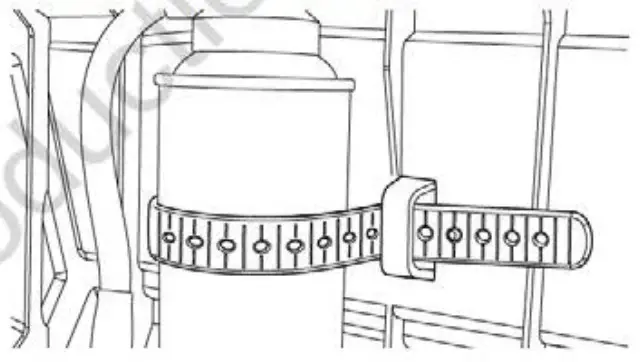
- Set the Pump Saver bottle in the space between the two slots.
- Wrap the strap over the bottle and feed through the slot and hook onto the knob.
Other Storage Tips
- DO NOT store fuel from one season to another unless it has been treated as described in Protect Fuel System.
- Replace the fuel container if it starts to rust. Rust and/or dirt in fuel can cause problems if it’s used with this unit.
- Cover the unit with a suitable protective cover that does not retain moisture.
 WARNING Storage covers could cause a fire resulting
WARNING Storage covers could cause a fire resulting
 in death or serious injury.
in death or serious injury.
• DO NOT place a storage cover over a hot pressure washer.
• Let equipment cool for a sufficient time before placing the cover on the equipment. - Store unit in a clean and dry area.
Troubleshooting/Specifications
| Problem | Cause | Correction |
| Pump has the following problems: failure to produce pressure. erratic pressure. chattering, loss of pressure, low water volume. | 1. Low-pressure spray tip installed.
2. Inadequate water supply. 3. Clogged inlet hose screen. 4. Spray tip is obstructed. 5. Connections leak. 6. High-pressure hose or spray gun leaks. |
1. Replace with high-pressure spray tip
2. Prov1de adequate water flow. 3. Check and clean the inlet hose screen. 4. Clean spray tip. 5. Tighten connections or replace o-ring. 6. Replace. |
| Deterrent fails to mix with spray. | 1. High-pressure spray tip installed.
2. Check ball stuck in the detergent siphoning system. 3. Detergent tube/tank is clogged or cracked. |
1. Replace with a low-pressure spray tip.
2. Free check ball. See Detergent Siphoning Check Ball. 3. Clean or replace detergent tube/tank. |
| Engine lacks power; will not start; starts and runs rough or shuts down during operation. | 1. Engine rocker switch set to
OFF (0) position. 2. Out of fuel. 3. Dirty air cleaner. 4. Spark plug wire not connected spark plug. |
1. Set engine rocker switch to
ON (I) position. 2. Fill fuel tank. 3. Clean or replace air cleaner. 4. Connect a wire to spark plug. |
For all other issues, see a Briggs & Stratton authorized dealer.
Specifications
Max Outlet Pressure . .. 3200 PSI (221 BAR)* @ 2.3 GPM (8.7 liters/min)
Max Flow Rate … . . . 2.4 GPM (9.0 liters/min)* @ 2800 PSI (193 BAR)
Water Supply Temperature ………. 1 OO” F (38’C) MAX
- This pressure washer is rated in accordance with the Pressure Washer Manufacturers Association (PWMA) standard PWIOl-2010 (Testing and Rating Performance of Pressure Washers).
Warranty
CRAFTSMAN WARRANTY POLICY
LIMITED WARRANTY Caaftsmandlo is a registered trademark of Stanley Stack & Decker Inc. and is used under license to line & Stratton. Briggs & Stratton warrants that, during the warranty period specified below, it will repair or replace, free of charge, any part that Is defective In material or workmanship or both. Transportation charges on products submitted for repair or replacement under this warranty must be borne by the purchaser. This warranty is effective for and Is subject to the time periods and conditions stated below. For warranty SPIlifER, find the nearest Authorized Service Caller in our dealer locator map at BRIGGSANOSTRATTON.COM. The purchaser must contact the Authorized Service Dealer, and then make the product available b the Authorized Service Dealer for inspection and testing. There is no other express warranty. Implied warranties, including those of merchantability and fitness for n particular purpose, are limited to the warranty period listed below, or to the extent permitted by law. Liability for incidental or consequential damages are ‘, retailed to the extent excursion is permitted by law. Some states or countries do riot allow limitations on hoes lung an implied warranty lasts, and some states or countries do not know the exclusion or limitation of incidental or consequential damages. so the alone limitation and exclusion may not apply to you. This warranty gives yet specific legal rights and you may also have other rights which vary from state to state or country to country.”
warranty PERIOD
| Item | CORSIMIIN Use | Commercial Use |
| Equipment | 24 months | 3 months |
| Engine’ | 24 months | 3 months |
| Frame | 36 months | 3 months |
- Applies to Briggs & Stratton engines only. Warranty coverage of non-Briggs & Stratton engines is provided by that engine manufacturer. Emissions-related components are covered by the Emissions Warranty Statement.
- In Australia – Our goods can* with guarantees that cannot be excluded under the Australian Consumer Law. You are entitled to a replacement or refund for a major failure and for compensation for any other reasonably foreseeable loss or damage YOU are also entitled to have the goods repaired or replaced if the goods fail to be of acceptable quality and the failure does not amount to a major failure. For warranty service, find the nearest Authorized Service Dealer in our dealer locator map at BRIGGSandSTRATTON.COM. or by calling 1300 274 447. or by emailing or writing to safesenquiresebriggsandstratton.com.au, Briggs & Stratton Australia Pty Ltd, 1 Moorebank Avenue, NSW, Australia. 2170. The warranty period begins on the date of purchase by the first rail or commercial consumer. “Consumer use” means personal residential household use by a retail consumer. “Commercial use” means all other uses, including use for commercial. income-producing or rental purposes. Once a product has experienced commercial use. it shall thereafter be considered as a commercial use product for purposes of this warranty. Save your proof of purchase receipt. If you do not provide proof of the initial purchase date at the time warranty service is requested. the manufacturing date of the product will be used to determine the warranty period. Product registration is not required to obtain warranty service on Briggs & Stratton products.
ABOUT YOUR WARRANTY
Warranty service is available only through Briggs & Stratton Authorized Service Dealers This warranty covers only defects in materials or workmanship. It does_ not cover damage caused by improper use or abuse, improper maintenance or repair, normal wear, and tear, or stale or unapproved fuel.
Improper Use and Abuse – The proper, intended use of this product is des. cribbed in the Operator’s Manual. Using the product in a way not described in the Operator’s Manual or using the product after it has hen damaged will not be covered under this warranty. Warranty coverage will also not be provided if the serial number on the product has been removed or the product has been altered or modified in any way, o if the product has evidence of abuse such as impact damage or water chemical corrosion damage. Improper Maintenance or Repair – This product must be maintained according to the procedures and schedules provided in the Operator’s Manual, and serviced or repaired using genuine Briggs & Stratton parts or equivalent. Damage caused by lack of maintenance or use of non-original parts is not covered by warranty.
Normal Wear and Mar – Like most mechanical devices, your unit is subject to wear then when properly maintained. This warranty does not cover repairs when normal use has exhausted the life of a part of the equipment. Maintenance and wear items such as filters, belts, cutting blades, and brake pads (except engine brake path) are not COviffed by warranty due to wear r.haracteristics alone unless the cause is due to defects in material or workmanship
Stale or Unapproved Fuel – In order to function correctly, this product requires fresh fuel that conforms to the criteria specified in the Operator’s Manual Engine or
equal)tl1el’lt damage caused by stale fuel or the use of unapproved fuels (such as Elf or E85 ethanol blend&) is not covered by warranty.
Other EXclus.ions – This warranty excludes damage due to accident, abuse, modification, alterations, improper servicing. freezing or chemical deterioration. Attachments or access. sones that were not originally packaged with the product ate also excluded. There is no warranty c.overve on equipment used for primary power in place of utility power or on equipment used in life support applications. This warranty does not include used, reconditioned, second-hand, or demonstration equipment or engines. This warranty also excludes failures due to acts of God and other force mature events beyond the manufacturer’s control.
80078024EN Rev A
FAQS
Does it work on wood decking?
The narrow pin point stream is very powerful. It is not recommended for use on painted surfaces, wood surfaces or items attached with and adhesive backing.
could I use this to wash area rugs?
The CMEPW1700 is ideal for outdoor applications such as washing your patio or car . We have not tested for cleaning rugs.
What size quick connects are recommended throughout the unit?
Quick connects are going to be 1/4”
Can I use with regular garden hose?
Yes and no
If you are talking about the water supply to the power washer, then the answer is yes. If you are talking about the water supply after the power washer, then the answer is no.
De que medida son las boquilla de conexion rapida?
the nozzle is 3.7×1.2×1.2 inch
does it exists on 20v ?
No, this one has cord
When you apply the soap by the applicator how do you do rubbing the soap?
The CMEPW1700 is not designed for rubbing the soap. The soap applicator provides powerful cleaning: 1700 MAX PSI* and 1.2 GPM
Can a bleach solution be used with this pressure washer?
Do not use bleach, chlorine, or any cleaners containing acids.
Is the pressure really strong enough to scrub a grimey driveway or deck?
In my opinion, it’s best for short, easy uses such as washing the car, cleaning windows, or small projects. Mine didn’t do so well.
Has someone found a foam cannon that fits the quick connect?
we apologize for the inconvenience. CRAFTSMAN does not have a foam cannon available at this time.
Can this be mounted to a wall?
No we do not recommend mounting the CMEPW1700 to a wall.
Is there only one pressure setting or can you vary the psi?
This model has only one pressure setting
Does it have wheels?
This pressure washer does not have wheels.
There are many reviews stating that their pressure washer started smoking, is this safe to use?
There are no known issues with this product. The CMEPW1700 is safe to use.
What is the small pin attached to the instructions for?
The pressure washer Includes CMEPW1700 Pressure Washer, (1) 40° Nozzle, (1) Turbo Nozzle, (1) Soap Applicator, (1) 20-ft Hose, (1) Trigger Assembly and (1) Wand Assembly. Unfortunately we are not showing a pin to be included with the unit.
Where is it made?
The model CMEPW1700 is made in Vietnam.
VIDEO


